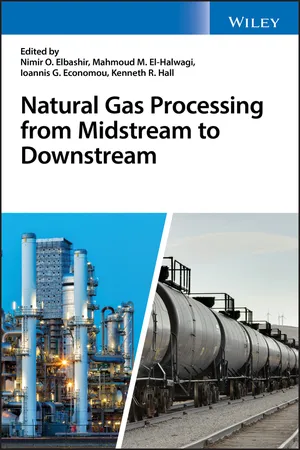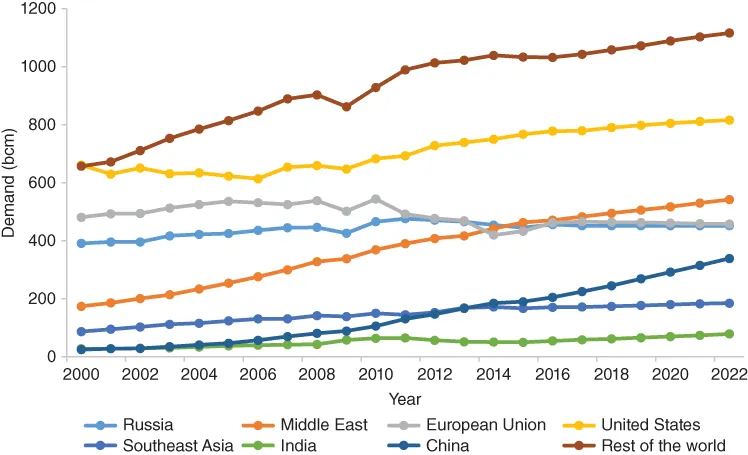
Natural Gas Processing from Midstream to Downstream
- English
- ePUB (mobile friendly)
- Available on iOS & Android
Natural Gas Processing from Midstream to Downstream
About this book
A comprehensive review of the current status and challenges for natural gas and shale gas production, treatment and monetization technologies
Natural Gas Processing from Midstream to Downstream presents an international perspective on the production and monetization of shale gas and natural gas. The authors review techno-economic assessments of the midstream and downstream natural gas processing technologies.
Comprehensive in scope, the text offers insight into the current status and the challenges facing the advancement of the midstream natural gas treatments. Treatments covered include gas sweeting processes, sulfur recovery units, gas dehydration and natural gas pipeline transportation.
The authors highlight the downstream processes including physical treatment and chemical conversion of both direct and indirect conversion. The book also contains an important overview of natural gas monetization processes and the potential for shale gas to play a role in the future of the energy market, specifically for the production of ultra-clean fuels and value-added chemicals. This vital resource:
- Provides fundamental chemical engineering aspects of natural gas technologies
- Covers topics related to upstream, midstream and downstream natural gas treatment and processing
- Contains well-integrated coverage of several technologies and processes for treatment and production of natural gas
- Highlights the economic factors and risks facing the monetization technologies
- Discusses supply chain, environmental and safety issues associated with the emerging shale gas industry
- Identifies future trends in educational and research opportunities, directions and emerging opportunities in natural gas monetization
- Includes contributions from leading researchers in academia and industry
Written for Industrial scientists, academic researchers and government agencies working on developing and sustaining state-of-the-art technologies in gas and fuels production and processing, Natural Gas Processing from Midstream to Downstream provides a broad overview of the current status and challenges for natural gas production, treatment and monetization technologies.
Frequently asked questions
- Essential is ideal for learners and professionals who enjoy exploring a wide range of subjects. Access the Essential Library with 800,000+ trusted titles and best-sellers across business, personal growth, and the humanities. Includes unlimited reading time and Standard Read Aloud voice.
- Complete: Perfect for advanced learners and researchers needing full, unrestricted access. Unlock 1.4M+ books across hundreds of subjects, including academic and specialized titles. The Complete Plan also includes advanced features like Premium Read Aloud and Research Assistant.
Please note we cannot support devices running on iOS 13 and Android 7 or earlier. Learn more about using the app.
Information
1
Introduction to Natural Gas Monetization
Chapter Menu
- 1.1 Introduction
- 1.2 Natural Gas Chain
- 1.3 Monetization Routes for Natural Gas
- 1.4 Natural Gas Conversion to Chemicals and Fuels
- 1.5 Summary
1.1 Introduction


Table of contents
- Cover
- Table of Contents
- Dedication
- List of Contributors
- About the Editors
- Preface
- 1 Introduction to Natural Gas Monetization
- 2 Techno‐Economic Analyses and Policy Implications of Environmental Remediation of Shale Gas Wells in the Barnett Shales
- 3 Thermodynamic Modeling of Natural Gas and Gas Condensate Mixtures
- 4 CO2 Injection in Coal Formations for Enhanced Coalbed Methane and CO2 Sequestration
- 5 Fluid Flow: Basics
- 6 Fluid Flow: Advanced Topics
- 7 Use of Process Simulators Upstream Through Midstream
- 8 Optimization of Natural Gas Network Operation under Uncertainty
- 9 A Multicriteria Optimization Approach to the Synthesis of Shale Gas Monetization Supply Chains
- 10 Study for the Optimal Operation of Natural Gas Liquid Recovery and Natural Gas Production
- 11 Modeling and Optimization of Natural Gas Processing and Production Networks
- 12 Process Safety in Natural Gas Industries
- 13 Thermodynamic Modeling of Relevance to Natural Gas Processing
- 14 Light Alkane Aromatization: Efficient use of Natural Gas
- 15 Techno‐Economic Analysis of Monetizing Shale Gas to Butadiene
- 16 Fractionation of the Gas‐to‐Liquid Diesel Fuels for Production of On‐Specification Diesel and Value‐Added Chemicals
- 17 An Energy Integrated Approach to Design a Supercritical Fischer‐Tropsch Synthesis Products Separation and Solvent Recovery System
- 18 Multi‐Scale Models for the Prediction of Microscopic Structure and Physical Properties of Chemical Systems Related to Natural Gas Technology
- 19 Natural Gas to Acetylene (GTA)/Ethylene (GTE)/Liquid Fuels (GTL) The Synfuels International, Inc. Process
- 20 Natural‐Gas‐Based SOFC in Distributed Electricity Generation: Modeling and Control
- 21 Design of Synthetic Jet Fuel Using Multivariate Statistical Methods
- Index
- End User License Agreement